Single-Wedge Lift-Out for Atom Probe Tomography Al/Ni Multilayers Specimen Preparation Based on Dual-Beam-FIB
Abstract
1. Introduction
2. Experimental
3. Standard Lift-Out
4. Single-Wedge Lift-Out
4.1. Experimental Considerations
4.2. Single-Wedge Lift-Out Tip Fabrication
4.2.1. Single-Wedge Milling
4.2.2. Off-Center Welding
4.2.3. Annular Milling
5. Conclusions
Author Contributions
Funding
Conflicts of Interest
References
- Panitz, J.A.; Mclane, S.B.; Müller, E. Calibration of the Atom Probe FIM. Rev. Sci. Instruments 1969, 40, 1321–1324. [Google Scholar] [CrossRef]
- Müller, E.; Tsong, T.T. Field Ion Microscopy: Principles and Applications; Elsevier: New York, NY, USA, 1969; pp. 109–127. [Google Scholar]
- Melmed, A.J. The art and science and other aspects of making sharp tips. J. Vac. Sci. Technol. B 1991, 9, 601. [Google Scholar] [CrossRef]
- Prosa, T.J.; Larson, D.J. Modern Focused-Ion-Beam-Based Site-Specific Specimen Preparation for Atom Probe Tomography. Microsc. Microanal. 2017, 23, 194–209. [Google Scholar] [CrossRef] [PubMed]
- Alexander, K.B.; Angelini, P.; Miller, M.K. Precision ion milling of field-ion specimens. J. Phys. Colloques. 1989, 50, C8-549–C8-554. [Google Scholar] [CrossRef]
- Cojocaru-Mirédin, O.; Choi, P.P.; Abou-Ras, D.; Schmidt, S.S.; Raabe, D. Characterization of Grain Boundaries in Cu(In,Ga)Se2 Films Using Atom-Probe Tomography. IEEE J. Photovolt. 2011, 1, 207–212. [Google Scholar] [CrossRef]
- Eichfeld, C.M.; Gerstl, S.S.A.; Prosa, T.; Ke, Y.; Redwing, J.M.; Mohney, S.E. Local electrode atom probe analysis of silicon nanowires grown with an aluminum catalyst. Nanotechnology 2012, 23, 215205. [Google Scholar] [CrossRef]
- Bran, J.; Jean, M.; Lardé, R.; Sauvage, X.; Breton, J.-M.L.; Pautrat, A. Elaboration and characterization of Cu/Co multilayered nanowires. J. Korean Phys. Soc. 2013, 62, 1744–1747. [Google Scholar] [CrossRef]
- Blumtritt, H.; Isheim, D.; Senz, S.; Seidman, D.N.; Moutanabbir, O. Preparation of nanowire specimens for laser-assisted atom probe tomography. Nanotechnology 2014, 25, 435704. [Google Scholar] [CrossRef]
- Chen, Y.; Rice, K.P.; Prosa, T.J.; Marquis, E.A.; Reed, R.C. Integrated APT/t-EBSD for Grain Boundary Analysis of Thermally Grown Oxide on a Ni-Based Superalloy. Microsc. Microanal. 2015, 21, 687–688. [Google Scholar] [CrossRef][Green Version]
- Estivill, R.; Audoit, G.; Barnes, J.-P.; Grenier, A.; Blavette, D. Preparation and Analysis of Atom Probe Tips by Xenon Focused Ion Beam Milling. Microsc. Microanal. 2016, 22, 576–582. [Google Scholar] [CrossRef]
- Larson, D.J.; Miller, M.K.; Ulfig, R.M.; Matyi, R.J.; Camus, P.P.; Kelly, T.F. Field ion specimen preparation from near-surface regions. Ultramicroscopy 1998, 73, 273–278. [Google Scholar] [CrossRef]
- Larson, D.J.; Foord, D.T.; Petford-Long, A.K.; Liew, H.; Blamire, M.G.; Cerezo, A.; Smith, G.D.W. Field-ion specimen preparation using focused ion-beam milling. Ultramicroscopy 1999, 79, 287–293. [Google Scholar] [CrossRef]
- Thompson, K.; Gorman, B.; Larson, D.J.; Leer, B.V.; Hong, L. Minimization of Ga Induced FIB Damage Using Low Energy Clean-up. Microsc. Microanal. 2006, 12, 1736–1737. [Google Scholar] [CrossRef]
- Mathew, P.T.; Rodriguez, B.J.; Fang, F. Atomic and Close-to-Atomic Scale Manufacturing: A Review on Atomic Layer Removal Methods Using Atomic Force Microscopy. Nanomanuf. Metrol. 2020, 3, 167–186. [Google Scholar] [CrossRef]
- Thompson, K.; Lawrence, D.; Larson, D.J.; Olson, J.D.; Kelly, T.F.; Gorman, B. In Situ Site-Specific Specimen Preparation for Atom Probe Tomography. Ultramicroscopy 2007, 107, 131–139. [Google Scholar] [CrossRef]
- Miller, M.K.; Russell, K.F.; Thompson, G.B. Strategies for fabricating atom probe specimens with a dual beam FIB. Ultramicroscopy 2005, 102, 287–298. [Google Scholar] [CrossRef]
- Miller, M.K.; Russell, K.F.; Thompson, K.; Alvis, R.; Larson, D.J. Review of Atom Probe FIB-Based Specimen Preparation Methods. Microsc. Microanal. 2007, 13, 428–436. [Google Scholar] [CrossRef]
- Zhongdu, H.; Zongwei, X.; Mathias, R.; Boteng, Y.; Tao, L.; Ying, S.; Fengzhou, F. Investigation of Ga ion implantation-induced damage in single-crystal 6H-SiC. J. Micromanuf. 2018, 1, 115–123. [Google Scholar] [CrossRef]
- Yexin, F.; Zongwei, X.; Ying, S.; Bing, D.; Zhifu, X.; Bing, L.; Lei, L.; Dongyu, T. Nano material removal mechanism of 4H-SiC in ion implantation-assisted machining. Comput. Mater. Sci. 2021, 200, 110837. [Google Scholar] [CrossRef]
- Zhang, Y.; Zhang, H.L.; Wu, J.H.; Wang, X.T. Enhanced thermal conductivity in copper matrix composites reinforced with titanium-coated diamond particles. Scr. Mater. 2011, 65, 1097–1100. [Google Scholar] [CrossRef]
- Qiu, X.; Wang, J. Experimental evidence of two-stage formation of Al3Ni in reactive Ni/Al multilayer foils. Scr. Mater. 2007, 56, 1055–1058. [Google Scholar] [CrossRef]
- Giannuzzi, L.A.; Drown, J.L.; Brown, S.R.; Irwin, R.B.; Stevie, F.A. Focused Ion Beam Milling and Micromanipulation Lift-Out for Site Specific Cross-Section Tem Specimen Preparation. MRS Proc. 1997, 480, 19. [Google Scholar] [CrossRef]
- Giannuzzi, L.A.; Stevie, F.A. A review of focused ion beam milling techniques for TEM specimen reparation. Micron 1999, 30, 197–204. [Google Scholar] [CrossRef]


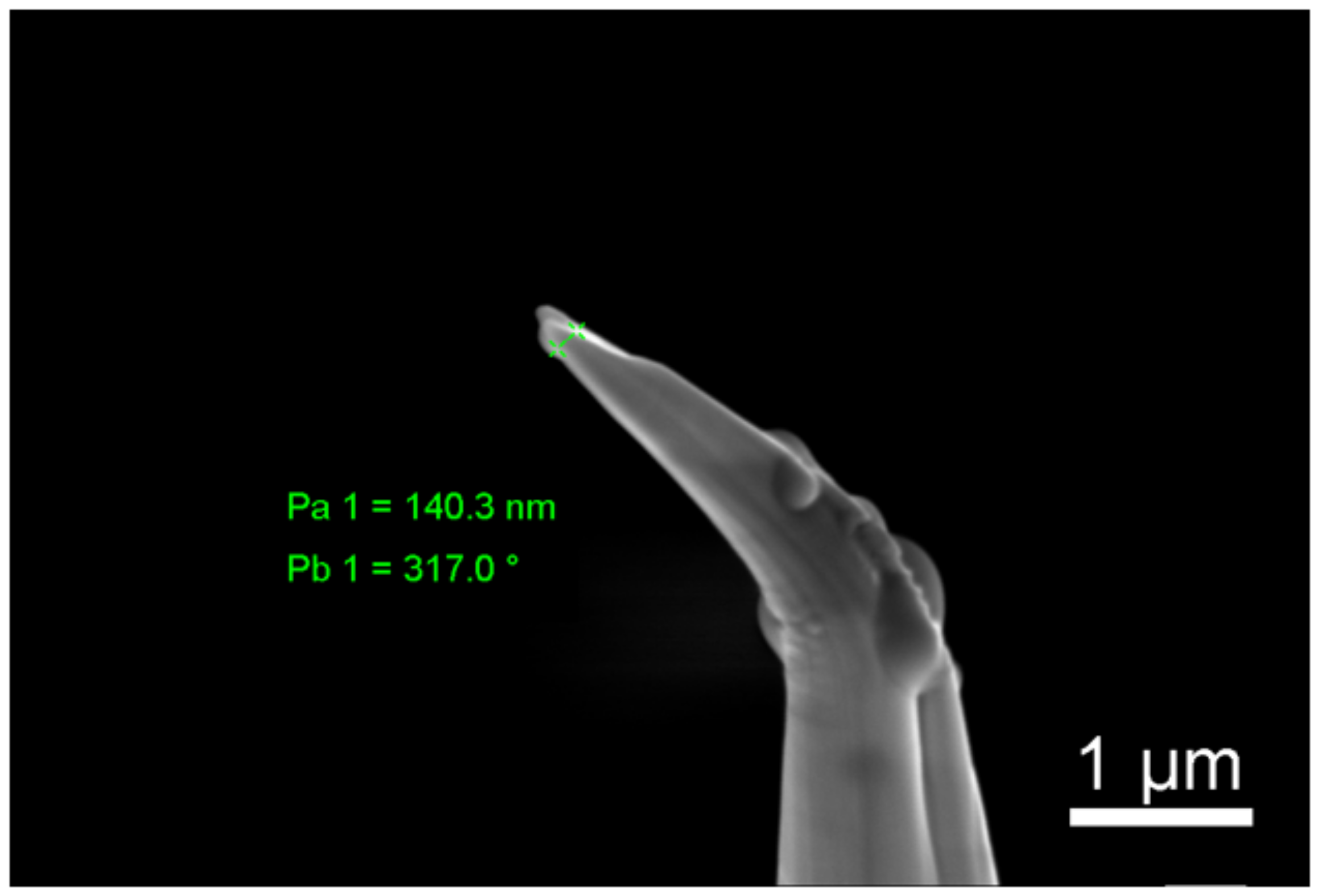


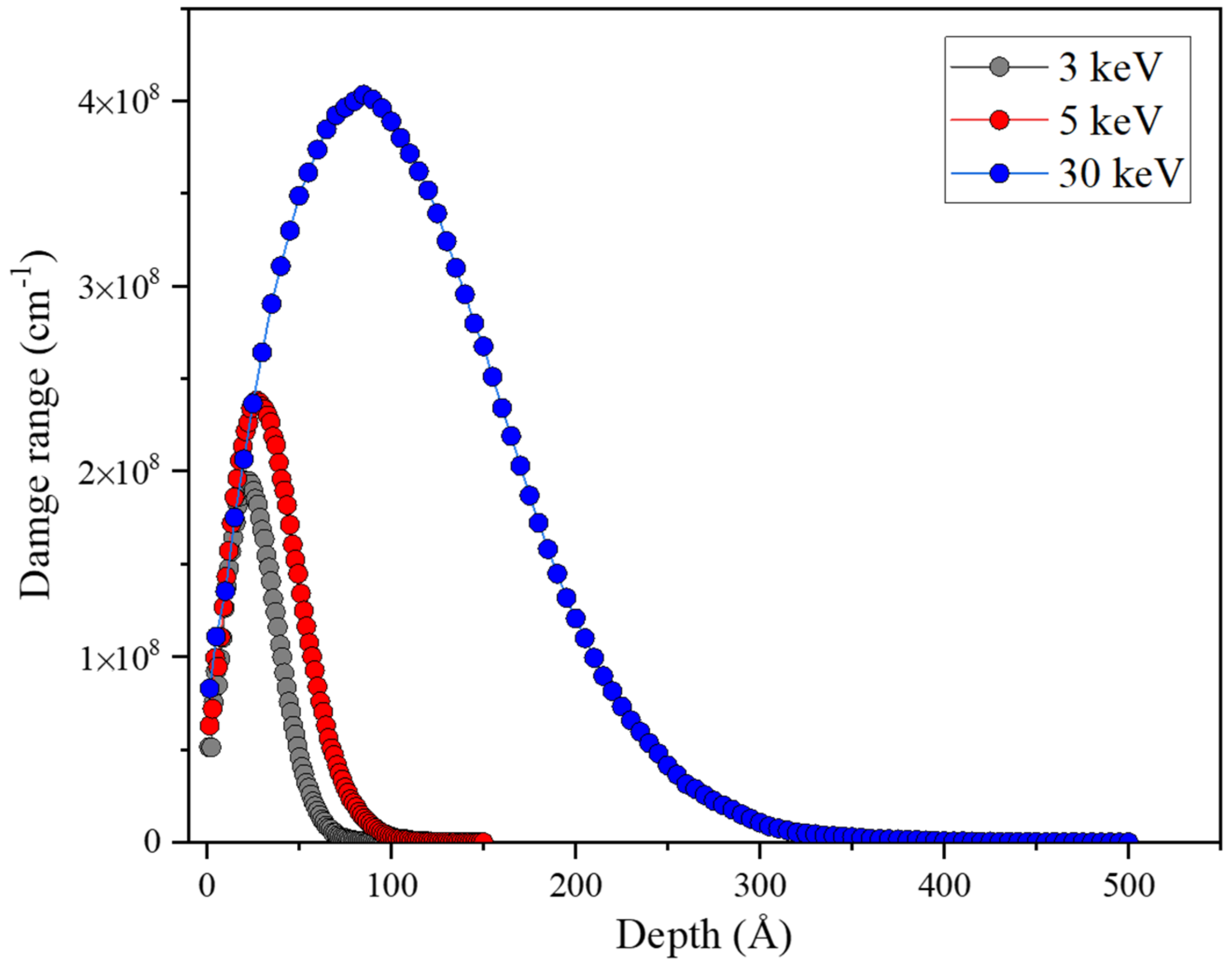
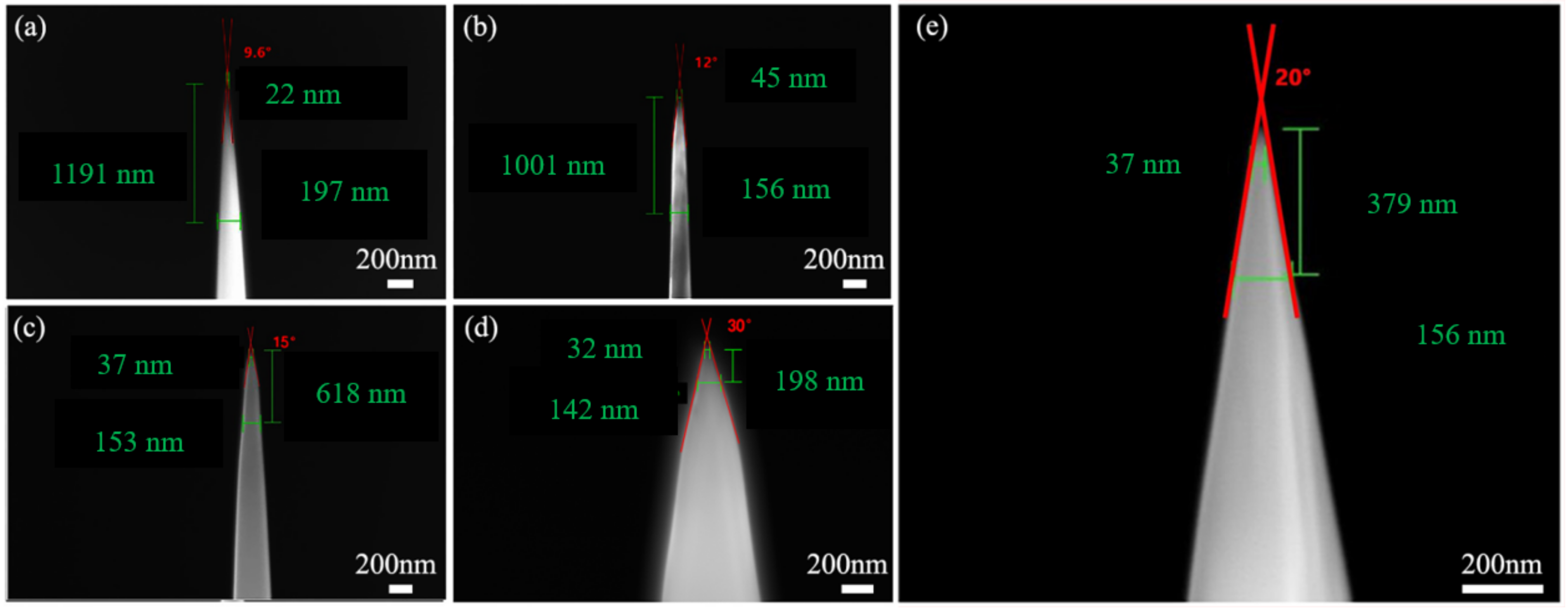
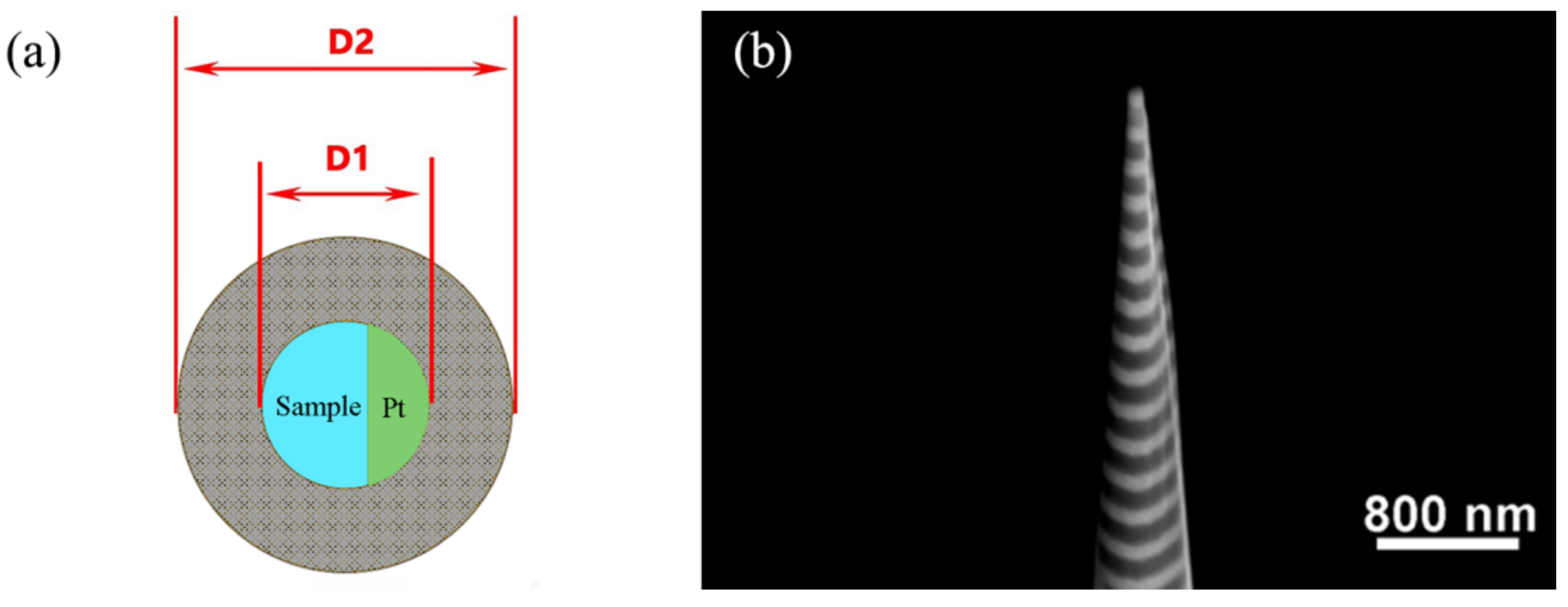
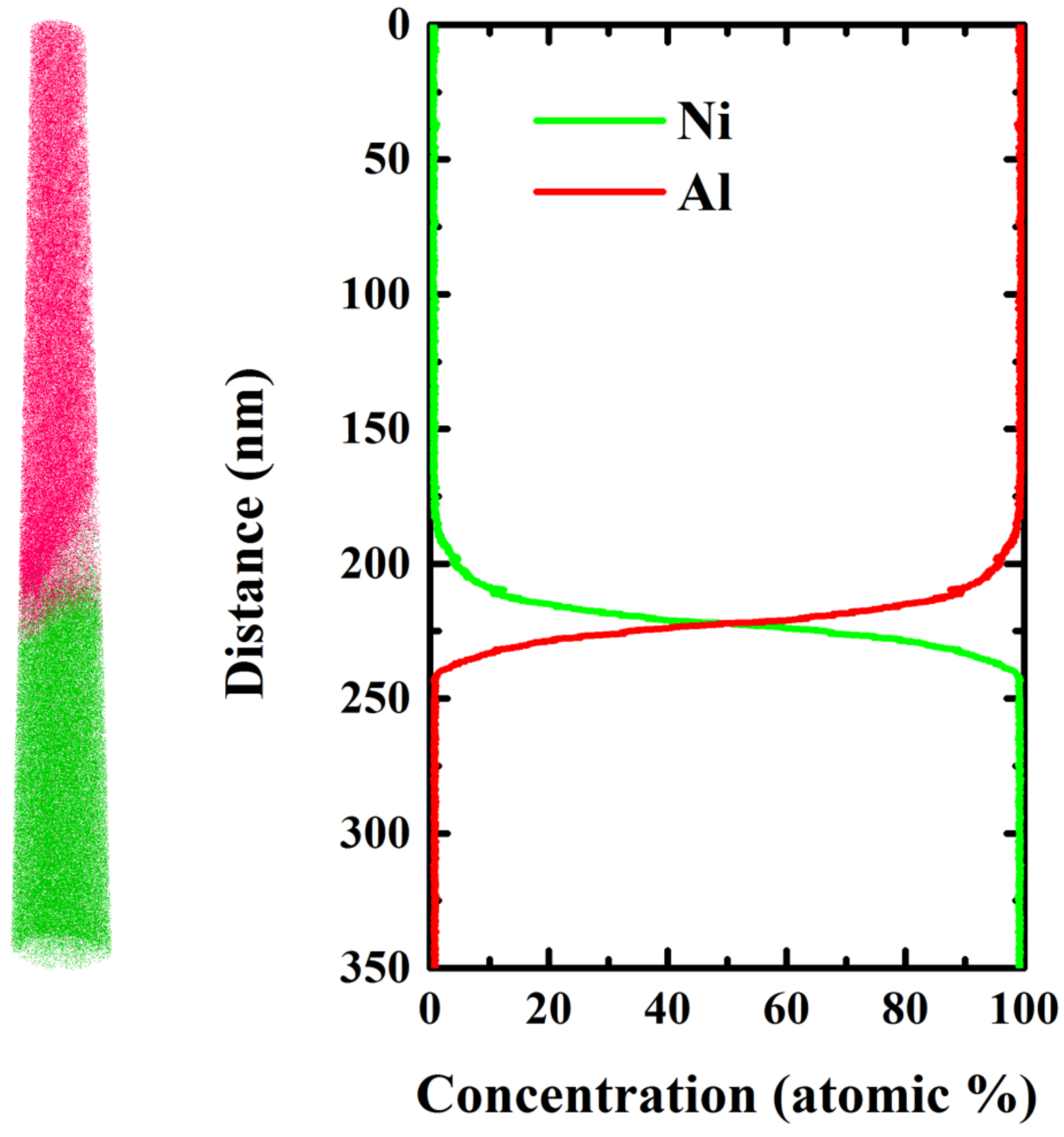
| Tip Diameter D/nm | Ion Beam Voltage U/kV | Ion Beam Current I/pA |
|---|---|---|
| 1000 | 30 | 240 |
| 200 | 15 | 120 |
| 100 | 10 | 20 |
| 50 | 10 | 2 |
Publisher’s Note: MDPI stays neutral with regard to jurisdictional claims in published maps and institutional affiliations. |
© 2021 by the authors. Licensee MDPI, Basel, Switzerland. This article is an open access article distributed under the terms and conditions of the Creative Commons Attribution (CC BY) license (https://creativecommons.org/licenses/by/4.0/).
Share and Cite
Qiao, Y.; Zhao, Y.; Zhang, Z.; Liu, B.; Li, F.; Tong, H.; Wu, J.; Zhou, Z.; Xu, Z.; Zhang, Y. Single-Wedge Lift-Out for Atom Probe Tomography Al/Ni Multilayers Specimen Preparation Based on Dual-Beam-FIB. Micromachines 2022, 13, 35. https://doi.org/10.3390/mi13010035
Qiao Y, Zhao Y, Zhang Z, Liu B, Li F, Tong H, Wu J, Zhou Z, Xu Z, Zhang Y. Single-Wedge Lift-Out for Atom Probe Tomography Al/Ni Multilayers Specimen Preparation Based on Dual-Beam-FIB. Micromachines. 2022; 13(1):35. https://doi.org/10.3390/mi13010035
Chicago/Turabian StyleQiao, Yi, Yalong Zhao, Zheng Zhang, Binbin Liu, Fusheng Li, Huan Tong, Jintong Wu, Zhanqi Zhou, Zongwei Xu, and Yue Zhang. 2022. "Single-Wedge Lift-Out for Atom Probe Tomography Al/Ni Multilayers Specimen Preparation Based on Dual-Beam-FIB" Micromachines 13, no. 1: 35. https://doi.org/10.3390/mi13010035
APA StyleQiao, Y., Zhao, Y., Zhang, Z., Liu, B., Li, F., Tong, H., Wu, J., Zhou, Z., Xu, Z., & Zhang, Y. (2022). Single-Wedge Lift-Out for Atom Probe Tomography Al/Ni Multilayers Specimen Preparation Based on Dual-Beam-FIB. Micromachines, 13(1), 35. https://doi.org/10.3390/mi13010035








